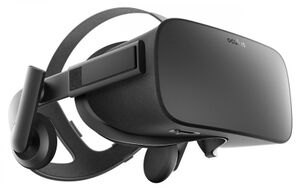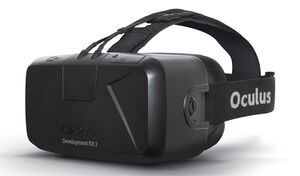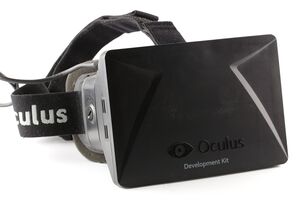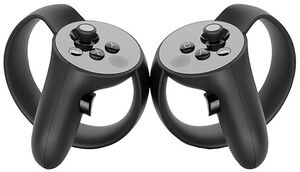Glossary:Meta
 |
|
| Website | |
|---|---|
| https://oculus.com/ | |
| Parent company | |
| Subsidiaries | |
| Reality Labs |
|
| Founded | |
| July 2012 | |
See virtual reality headset article for more information. For a list of games, see List of VR games.
Key points
- Rift Core 2.0 update introduces new Dash UI and new minimum and recommended system requirements[1]
- Playing games from outside the Oculus Store requires enabling
Unknown Sources. - Some games may only support Rift DK1 or DK2, and not support the Consumer Version of the Oculus Rift. LibOVRWrapper can make some DK1/DK2 games compatible with the consumer headset.
General information
Headsets
Oculus Rift
- Discontinued in 2019. Succeeded by Oculus Rift S.
- Oculus Rift + Touch includes the headset, 2x Oculus Touch controllers and 2x Oculus Sensors. Some older models also included 1x Xbox One Controller.
- Additional Sensors needed for room-scale tracking.
| Features and specification: | |
|---|---|
| 3D | Stereoscopic 3D |
| Display | 1080 x 1200 per eye. Total resolution of 2160 x 1200. 90 Hz Low Persistence OLED, 110° FOV. |
| Tracking | The Oculus Rift uses the Oculus Sensor camera to track the headset and Touch controllers positional via Constellation tracking. 1x Oculus sensor allows for seated play with an Xbox One Controller or Oculus Remote. 2x Oculus Sensors allows for standing with Oculus Touch controllers. 3x Oculus Sensors allows for room-scale tracking with Oculus Touch Controllers. |
| Audio | Integrated headphones and microphone. Headphones can be replaced with earphones. |
| Features | 4m cable, Hardware adjustable IPD and Proximity sensor. |
| Windows | ||
|---|---|---|
| Minimum | Recommended | |
| Operating system (OS) | 10 | |
| Processor (CPU) | Intel Core i3-6100 AMD FX-4350 AMD Ryzen 3 1200 |
Intel Core i5-4590 AMD Ryzen 5 1500X |
| System memory (RAM) | 8 GB | 8 GB+ |
| Hard disk drive (HDD) | ||
| Video card (GPU) | Nvidia GeForce GTX 1050 Ti Nvidia GeForce GTX 960 AMD Radeon RX 470 AMD Radeon R9 290 | Nvidia GeForce GTX 1060 Nvidia GeForce GTX 970 AMD Radeon RX 480 AMD Radeon R9 290 |
| Other | 1x USB 3.0, 2x USB 2.0 HDMI 1.3 |
3x USB 3.0, 1x USB 2.0 HDMI 1.3 |
Oculus Rift S
- Discontinued in 2021. Succeeded by Oculus Quest 2.
| Features and specification: | |
|---|---|
| 3D | Stereoscopic 3D |
| Display | 1280 x 1440 per eye. Total resolution of 2560 x 1440. 80 Hz Fast-switch LCD, 115° FOV. |
| Tracking | The Oculus Rift S uses five built-in cameras for inside-out tracking. Oculus Sensors for the original Rift can be optionally used to enhance tracking quality. |
| Audio | Speakers are integrated into the headband. 3.5mm headphone jack is present to use external headphones. |
| Features | 5m cable. |
| Windows | ||
|---|---|---|
| Minimum | Recommended | |
| Operating system (OS) | 10 | |
| Processor (CPU) | Intel Core i3-6100 AMD FX-4350 AMD Ryzen 3 1200 |
Intel Core i5-4590 AMD Ryzen 5 1500X |
| System memory (RAM) | 8 GB | 8 GB+ |
| Hard disk drive (HDD) | ||
| Video card (GPU) | Nvidia GeForce GTX 1050 Ti Nvidia GeForce GTX 960 AMD Radeon RX 470 AMD Radeon R9 290 | Nvidia GeForce GTX 1060 Nvidia GeForce GTX 970 AMD Radeon RX 480 AMD Radeon R9 290 |
| Other | 1x USB 3.0 DisplayPort 1.2 or Mini DisplayPort |
1x USB 3.0 DisplayPort 1.2 |
Oculus Quest
- Standalone mobile headset which can be connected into PC using Oculus Link cable.
- Discontinued in 2020. Succeeded by Oculus Quest 2.
| Features and specification: | |
|---|---|
| 3D | Stereoscopic 3D |
| Display | 1440 x 1600 per eye. Total resolution of 2880 x 1600. 72 Hz OLED, 110° FOV. |
| Tracking | The Oculus Quest uses four built-in cameras for inside-out tracking. |
| Audio | Built-in headphones. Two 3.5mm headphone jacks are present to use external headphones. |
| Features | Qualcomm Snapdragon 835 processor, Android based operating system, Hardware adjustable IPD, can interface with PC Oculus software via Oculus Link |
Oculus Quest 2
- Standalone mobile headset which can be connected into PC using Oculus Link cable.
- A Facebook account is required to use the Quest 2.
| Features and specification: | |
|---|---|
| 3D | Stereoscopic 3D |
| Display | 1832 x 1920 per eye. Total resolution of 3664 x 1920. 90 Hz LCD, 110° FOV. |
| Tracking | The Oculus Quest 2 uses four built-in cameras for inside-out tracking. |
| Audio | |
| Features | Qualcomm Snapdragon XR2 processor, Android based operating system, Hardware adjustable IPD, can interface with PC Oculus software via Oculus Link |
Oculus Rift Development Kit 2
Oculus Rift Development Kit 2 aka DK2 was the second release of the headset for developers. Supports seated and standing positional tracking. It is still supported within Oculus Store, and can be used with an Xbox One Controller to play non- touch controller games.
- Some games on Steam will only support the Oculus Rift Development Kit 2, and will not work with the Consumer Version Oculus Rift.
| Features and specification: | |
|---|---|
| Display | 960 × 1080 per eye. Total resolution of 1920 x 1080. 75Hz Low Persistence OLED. 100° FOV. |
| Tracking | Positional tracking with Oculus DK2 IR Camera via Constellation tracking. |
Oculus Rift Development Kit 1
Oculus Rift Development Kit 1 aka DK1 was Oculus' first release of a headset[2]. It only supports rotational tracking, o positional tracking, thus it can only be used for seated and a few standing rotational experiences. It not supported by the Oculus Store.
- Some games on Steam will only support the Oculus Rift Development Kit 1, but will not work with the Consumer Version Oculus Rift or Oculus Rift Development Kit 2.
| Features and specification: | |
|---|---|
| Display | 640 x 800 per eye. Total resolution of 1280 x 800. 60Hz High Persistence LCD. 110° FOV. |
| Tracking | Rotational tracking only, using Gyroscope, Accelerometer and Magnetometer. |
Controllers
Oculus Remote
Comes in the box, can be used to play simple movies and experiences that don't require interaction or gameplay.
Oculus Touch
Oculus Touch comes with an additional Oculus Sensor, and can be either be bought separately from the Oculus rift, or brought together in the Oculus Rift + Touch bundle. they use positional tracking, and have a thumbstick, trigger, grip analogue, two face buttons and a system button. The thumb and the index finger are positionally tracked.
References
- ↑ Rift Core 2.0 Updates: Beta Coming Soon, Plus Redesigned Desktop App Experience
- ↑ Oculus Rift DK1 Specs - VRcompare - last accessed on 2020-06-22




